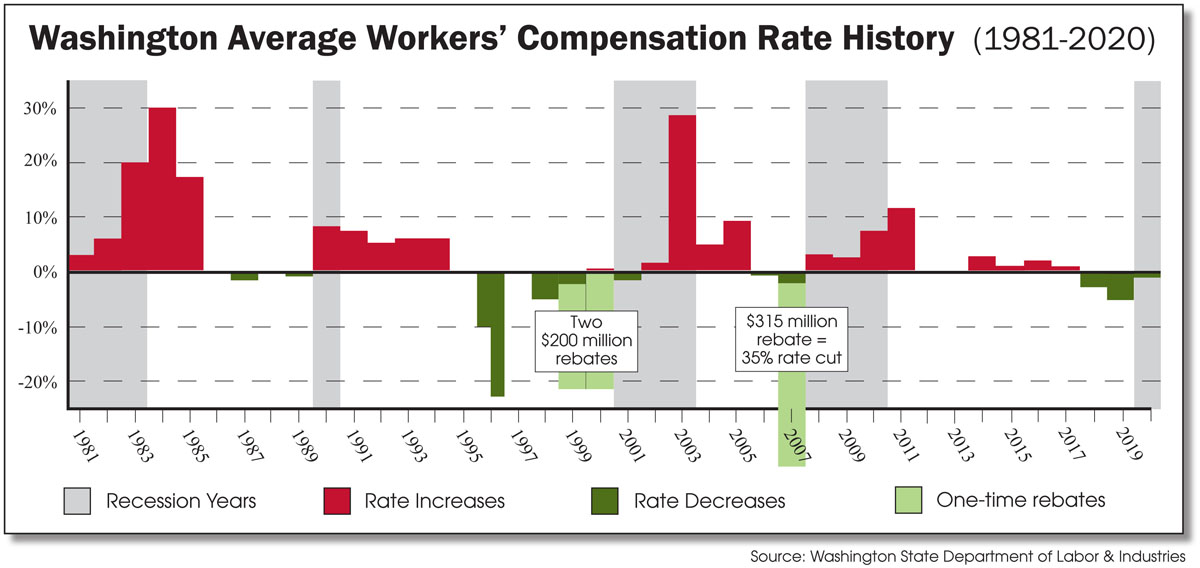STATE GOVERNMENT
History lesson: Hands off workers’ compensation
It took a decade to recover from the system’s last “recession raid.” Never again.
By DAVID GROVES
The Stand
 OLYMPIA (June 23, 2020) — It’s official. We’re in a recession — and have been since February. Although this one will be unique in many ways, in one way it is sure to be the same as all other economic downturns: corporate lobbying groups in Olympia will be looking for ways to save struggling businesses some cash.
OLYMPIA (June 23, 2020) — It’s official. We’re in a recession — and have been since February. Although this one will be unique in many ways, in one way it is sure to be the same as all other economic downturns: corporate lobbying groups in Olympia will be looking for ways to save struggling businesses some cash.
The latest revenue forecast estimates that Washington state government faces a $8.8 billion revenue shortfall through 2023, so it’s a difficult time to pitch tax cuts. A historic spike in pandemic-related layoffs means hundreds of millions of dollars in unemployment benefits are sustaining families and the local businesses where that money is spent. So pushing for unemployment tax cuts seems like a non-starter.
So that leaves… workers’ comp!
Washington’s workers’ compensation system is a critical safety net for working families. The system’s statutory goal is “to provide sure and certain relief for workers, injured in their work, and their families and dependents.” Its benefits help thousands of Washington families avoid economic catastrophe when someone is injured or sickened at work.
In 2020, the average premium rates that employers pay for workers’ compensation coverage in Washington decreased by 0.8 percent, the third straight year those rates have declined. Given the relative health of Washington’s safety net for injured workers, there’s chatter in Olympia that business lobbying groups may seek a workers’ compensation rate cut or rebate. But be warned. We’ve been in this situation before and the outcome is clear. Approving rate cuts and rebates as the economy enters a recession is a recipe for major rate increases at the worst possible time, when the state economy is trying to pull out of that recession.
Just prior to the last two recessions — in 2001-03 and 2008-10 — businesses were given significant rate cuts and one-time rebates when it seemed as though the workers’ compensation trust funds were flush with cash. Businesses got $200 million in workers’ comp rebates in both 1999 and 2000, and ended up having to pay it all back, and then some, in the form of rate increases in the years that followed to keep the system solvent. That included a massive 28.8 percent rate increase in 2003. Just as the system stabilized, another $315 million rebate in 2007 led to four straight years of rate increases in the middle of the Great Recession. (See the chart above and the source data here.)
After that last experience, everyone vowed: never again.
Business and labor stakeholders on the Workers’ Compensation Advisory Committee (WCAC) set targets for rebuilding the system’s reserves while also lowering projections for future investment earnings. That’s why, between 2014-17, the state Department of Labor and Industries began a series of small rate increases that would not have been necessary except to make progress toward WCAC targets — supported by both labor and business representatives — to establish reserves sufficient to withstand the next recession.
Well, here we are. And if we forget our history and approve more rate cuts or rebates, we will have abandoned all of that work and set ourselves up for major rate increases again.
Our workers’ comp system is unique and competitive
Our system is unique from other states’ in several ways:
► By popular demand, it is state-run. (A business-funded 2010 initiative to privatize it failed overwhelmingly, losing in every single county.) That means there are no profit margins and marketing expenses that boost costs.
► Its premiums are based on hours worked, not on wages paid. That means the cost of coverage doesn’t automatically rise in Washington as wages increase, like it does in all other states.
► Washington is the only state where workers pay a portion of the premiums (roughly 26% in 2020). Because workers pay into the system, our state has always sought to maintain a strong safety net for families who have lost their source income due to work-related illness or injury. That’s why the system’s benefits are generally higher here than in other states.
 And that’s where the tassel-toed business lobbyists hang their rhetorical hats when they criticize the system. They claim that Washington has the highest “benefit costs” in the nation. It’s a deliberate obfuscation.
And that’s where the tassel-toed business lobbyists hang their rhetorical hats when they criticize the system. They claim that Washington has the highest “benefit costs” in the nation. It’s a deliberate obfuscation.
By some measures, Washington state has among the highest benefit levels provided to injured workers. But in terms of the costs paid by employers and workers, Washington is in the middle of the pack, ranked 16th highest in the latest state-by-state comparison by the Oregon Department of Consumer and Business Services.
And Washington employers have it even better than that. The Oregon study doesn’t account for the fact that workers pay a portion of the premiums in Washington and that many employers get a portion of their premiums refunded through the state’s Retrospective Rating Program. So in terms of employers’ costs for workers’ compensation coverage, Washington is actually in the mid-30s in terms of state rankings. To put it another way, fewer than one-third of all states have lower rates than Washington.
Yes, Washington has comparatively high benefits, but it also has comparatively low employer costs. The Washington State Labor Council, AFL-CIO contends that this exactly the type of system Washington needs to maintain, one that takes good care of workers who’ve temporarily or permanently lost their family’s livelihoods due to work-related injuries or disease, but does so at a competitive cost to the state’s employers.
If businesses in Washington want to maintain those competitive and stable workers’ compensation premium rates, they should resist the temptation to seek rebates and rate cuts amid a recession. As history has shown, they would pay a steep price for that short-term gain.






